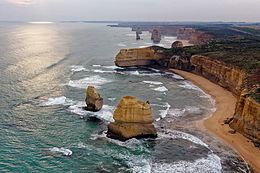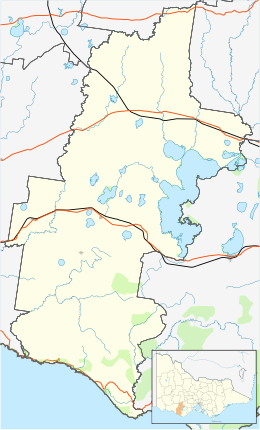The Twelve Apostles (Victoria)
 |
|
|
Location within Shire of Corangamite and, inset, Victoria
|
|
| Geography | |
|---|---|
| Location | Near Port Campbell, Victoria |
| Coordinates | 38°39′57″S 143°06′16″E / 38.66583°S 143.10444°E |
| Administration | |
|
Australia
|
|
| State | Victoria |
| LGA | Shire of Corangamite |
The Twelve Apostles is a collection of limestone stacks off the shore of the Port Campbell National Park, by the Great Ocean Road in Victoria, Australia. Their proximity to one another has made the site a popular tourist attraction. Currently there are eight Apostles left, the ninth having collapsed dramatically in July 2005. The name remains significant and spectacular especially in the Australian tourism industry.
The apostles were formed by erosion: the harsh and extreme weather conditions from the Southern Ocean gradually eroded the soft limestone to form caves in the cliffs, which then became arches, which in turn collapsed; leaving rock stacks up to 50 metres high. Now because of this erosion there are fewer than ten remaining. The site was known as the Sow and Pigs (Muttonbird Island, near Loch Ard Gorge, was the 'Sow', and the smaller rock stacks were the 'Piglets'), the Pinnacles or the Twelve Apostles. The formation eventually became known as the Twelve Apostles, despite only ever having nine stacks.
In 2002, the Port Campbell Professional Fishermens Association unsuccessfully attempted to block the creation of a proposed marine national park at the Twelve Apostles location, but were satisfied with the later Victorian Government decision not to allow seismic exploration at the same site by Benaris Energy; believing it would harm marine life.
The stacks are susceptible to further erosion from the waves. On 3 July 2005, a 50-metre-tall (160 ft) stack collapsed, leaving eight remaining. On 25 September 2009, it was thought that another of the stacks had fallen, but this was actually one of the smaller stacks of the Three Sisters formation. The rate of erosion at the base of the limestone pillars is approximately 2 cm per year. Due to wave action eroding the cliff face existing headlands are expected to become new limestone stacks in the future.
...
Wikipedia

